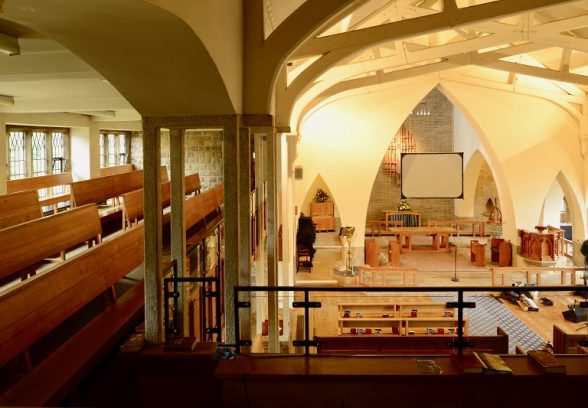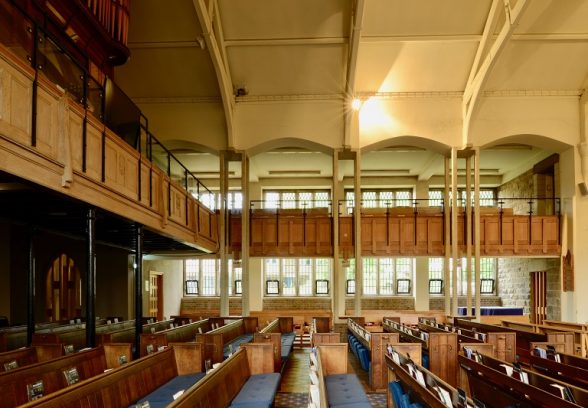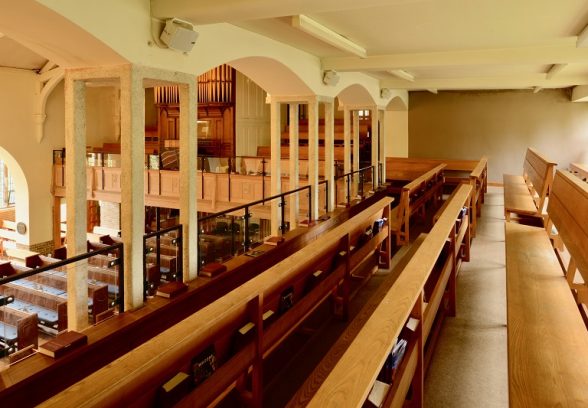This website uses cookies
This website uses cookies to enable it to function properly and to analyse how the website is used. Please click 'Close' to accept and continue using the website.





The C20 Society has recently won a case to protect work by George Pace which constitutes the most architecturally significant element of Christ Church Fulwood. The Society took the case to the Consistory Court of the diocese and the decision in our favour was announced just before Christmas.
Christ Church Fulwood is one of the vast majority of Church of England church buildings across the country which has evolved and altered over its lifetime. Originally designed by Robert Potter in 1837-9, the significant phase in the architectural development of this church came in the mid-twentieth century when the most acclaimed of all the post-war ecclesiastical architects, George Pace, was commissioned to enlarge the building. As a result, the chancel and south aisle were added in 1953-6 and the north aisle in 1963 to Pace’s designs. Unusually for an originally older church, the Grade II listing description makes little mention of the 19th century work after the basic descriptive section, but clearly indicates that the significance lies with the 20th century work, concluding that it is ‘a major example’ of Pace’s work. This view is reinforced in the recently published revised Buildings of England volume (Pevsner) which states that ‘it is Pace’s work that makes the church noteworthy.’ Christ Chuch Fulwood is one of his early works, and added completely new elements, rather than being purely a conversion project. Pace undertook it soon after moving to the Sheffield area to work for the diocese, preceding his appointment as cathedral architect.
George Pace’s work at Christ Church transformed the church. The chancel added a magnificent focal point to the entire building, his ingenious design characteristically using indirect lighting beaming down onto the altar from the towering space above. It is this tower, with its blank wall behind the altar and its diffuse lighting, which creates a sense of uplift and space in the building as a whole. This stunning addition to the church has simple arches which connect it to the nave and create a crossing feature of great power. Pace’s work merges almost seamlessly with the earlier nave and was completed with the addition of another aisle and gallery overseen by his partner, Ronald Sims. The altar was later moved forward to fit in with changes in liturgical fashion, but this change has not diminished its impact.
The development at Christ Church Fulwood has been a case for C20 for over four years. During this time the local congregation and their architects have been preparing a scheme to bring the facilities of their church and church hall up to 21st century standards in order to accommodate their changing needs and an expanding congregation. Amongst a wide range of alterations which were well-justified, there was one element which was ill-advised. This was the proposal to block off Pace’s beautiful chancel space to install ancillary space and an upstairs office in the tower. From the earliest consultation, we warned the church that this proposal was, in our opinion, highly damaging to the significance of the listed building and should be re-considered. Our view was shared and reinforced by Historic England, the Church Buildings Council and the Victorian Society.
Despite this and further design iterations, the detrimental proposals for the chancel were retained in the formal faculty application when it was submitted last year. The Society took the decision that the destruction of this most significant work by Pace was not acceptable and, alone amongst the earlier objectors, took the case to the Consistory Court of the diocese. The judgement of the Chancellor was released just before Christmas. We were thrilled that, after carefully weighing up all the arguments, she allowed Christ Church to proceed with all their proposed works except for the unjustifiable and destructive works proposed for the chancel. The Society commends this decision as fair and sensible, allowing the congregation the flexibility they seek, whilst ensuring that the significant twentieth century architectural legacy of this church is maintained for future generations. The Society looks forward to working with the parish in the future to make the most of their wonderful building.

Become a C20 member today and help save our modern design heritage.